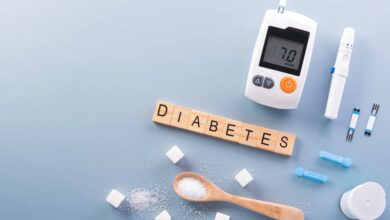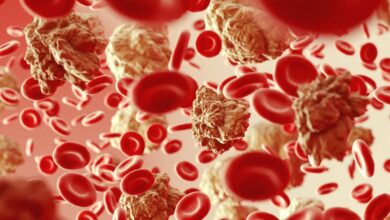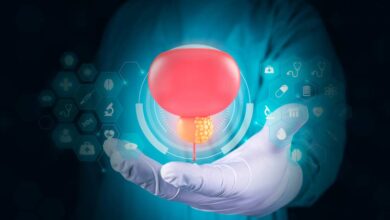Benign Breast Tumors: Can they become cancerous?

Benign breast tumors are non-cancerous growths in the breast tissue that are not usually life-threatening. However, it is important for women to be aware of this condition and see a doctor if they notice any breast changes.
Histological diagnosis remains the gold standard procedure to diagnose benign breast tumors, ensuring accurate identification of these masses and distinguishing them from malignant growths. Biopsy is recommended as the preferred diagnostic method for different types of benign tumors.
Although benign breast tumors are usually not serious, it is important to consult a doctor as soon as you see or feel anything out of the ordinary in the breast.
Among the symptoms or changes that a woman may feel are:
- The appearance of a breast lump: This is the most common symptom, and the lump may vary in size, shape and texture.
- Breast pain: The pain may be general or can occur when the breast is touched, and may get worse before menstruation.
- Nipple discharge: Clear, yellowish, brown, or even bloody discharge from the nipple can occur.
- Changes in the breast shape or size: A woman may notice a change in the size or shape of one or both breasts.
- Peeling, scaling, crusting or flaking of the skin on the breast: In some cases, the woman notices peeling, dark color or redness in the breast skin.
- Skin dimpling: The breast skin may appear shrunken or sunken.
The doctor needs to make an accurate diagnosis to rule out any other possibilities. The steps followed in diagnosing benign tumors include:
Clinical Breast Examination
A clinical breast exam (CBE) is a physical exam of the breasts in order to detect a lump in your breast. The doctor also checks the armpit area to make sure there are no swollen lymph nodes.
Imaging examinations
- Ultrasound: A breast ultrasound can show whether a breast lump is a fluid-filled breast cyst (usually not cancerous) or a solid mass (which could be cancer and may need further testing).
- Mammography: Mammograms are X-ray images of your breasts designed to detect cancers and other changes in breast tissue.
- MRI: In some cases, your doctor may recommend a breast MRI if the diagnosis isn’t clear using ultrasound or mammography.
Breast Biopsy
Sometimes, your doctor may need to take a sample of breast tissue for a microscopic examination to confirm the diagnosis. There are different types of biopsies, and the doctor may choose the most appropriate type based on the condition.
Types of Benign Breast Tumors
- Fibroadenoma: It is the most common type of benign tumors, and most often affects women of reproductive age. It is a unilateral, benign (non-cancerous) breast tumor that is a solid, not fluid-filled, lump and usually occurs in women between the ages of 20 and 35 years. The lump may feel larger or smaller during the menstrual cycle and is usually painless.
- Fibrocystic breast changes: Fibrocystic breast changes are common and benign changes within the breast characterized by a dense irregular and bumpy consistency in the breast tissue. They are more common before menopause and are not a cause for concern.
- Papillomas: They are benign (noncancerous) tumors that form in your breast’s milk ducts. Often, they’re asymptomatic. But sometimes, they cause clear or bloody discharge from your nipple.
- Lipomas: A lipoma is a lump of fatty tissue that grows just under the skin. Lipomas move easily when you touch them and feel rubbery, not hard. It does not cause changes in the breast skin and rarely causes nipple discharge.
Do they turn into cancer?
In some rare cases, benign breast tumors can turn into cancer. However, this is very rare. All women should do routine check-ups and follow-ups with their doctor and have regular breast exams (mammograms, ultrasounds etc.) according to the approved medical recommendations. If the doctor notices any suspicious changes in the benign tumor or breast, they may decide to perform further tests to rule out any cancerous transformation.
When the benign breast tumor grows quickly in an unusual way, it may be a cause of concern. Also, any change in its shape or size may indicate the presence of cancer.
If a benign tumor causes severe or persistent pain, it may be an indication of a more serious problem. Sometimes the texture may change and it can suddenly become harder, or for example, the skin color may change and can become red with swelling or ulcers. All of these changes require an immediate visit to the doctor to be properly evaluated and to obtain appropriate medical guidance. However, there are some risk factors that can increase the possibility of a benign breast tumor turning into cancer. Nevertheless, these factors do not necessarily mean that a benign tumor will turn into cancer, but rather require further monitoring and regular follow-ups by a specialist doctor.
Risk factors include:
- Family history of cancer: Having a family history of breast cancer increases the risk of cancer transformation.
- Personal history of cancer: Having a previous history of breast cancer increases the risk of benign tumors turning into cancer.
- Age: As we age, benign tumors are more prone to becoming cancerous. For instance, women over the age of 50 have a higher risk.
History of radiation exposure: Past radiation exposure to the breast area, such as radiation treatment for another cancer, increases the risk of cancer transformation.
The presence of suspicious changes: If there are suspicious changes in a benign tumor, such as rapid growth or changes in shape or texture, this may increase the possibility of it turning into cancer.
In such cases, doctors assess the risk factors and the patient’s medical history to identify potential risks and make appropriate treatment decisions.
Suggested Treatments
Usually, benign breast tumors do not pose a serious health risk and do not require immediate treatment. Rather, the doctor simply monitors them closely to notice any possible changes that may occur. However, in some cases, these tumors can cause disturbing symptoms or cause anxiety for the woman, and in these cases some treatment measures may be taken. Modern treatments for benign breast tumors include:
3D Mammography: It is a modern technology that helps improve the detection of benign breast tumors and provides clearer images for their evaluation.
Breast Ultrasound: Aims to analyze the structure of breast tumors and determine their nature. They can be used to help precisely guide a needle to a suspicious area or in other surgical procedures if needed.
Lumpectomy: When benign breast tumors cause irritating symptoms or need to be removed for aesthetic purposes, lumpectomy can be performed to remove the tumor without removing the entire breast.
Educating women and aising awareness: The path towards enhancing health awareness and self-care
Education and awareness help women understand the importance of early detection of breast cancer. When a woman learns about the signs and symptoms of cancer and knows how to do a breast self-examination and when to see a doctor, she can act quickly if she detects any suspicious breast change. Early detection and treatment can lead to better treatment outcomes, as the disease may be in its initial stages, making it more responsive to treatment. Early detection and treatment can also prevent the disease from progressing, reducing the risk of complications and improving long-term health.
Promoting prevention and self-care contributes to enhancing awareness of breast cancer prevention methods and the importance of breast self-care. Women can learn about the factors that contribute to an increased risk of breast cancer and take preventive measures such as maintaining a healthy diet, exercising, and avoiding smoking and alcohol. Breast self-care is enhanced through regular breast self-exams and going to your doctor for an annual checkup. Education can also help women deal with the psychological and emotional challenges associated with breast cancer. By understanding information about cancer, available treatments and support, women can feel confident and reassured and make the right decisions to care for their health.
In general, educating and raising women’s awareness about breast tumors and the importance of regular check-ups help in promoting health awareness, early diagnosis, self-care, and rapid response to any suspected changes. Educating and raising women’s awareness about breast tumors and the importance of regular check-ups is of utmost importance for several reasons:
Early detection of breast cancer: Education and awareness help women understand the importance of early detection of breast cancer. When a woman learns about the signs and symptoms of cancer and knows how to perform breast self-exams and when to see a doctor, she can act quickly if she detects any suspicious breast change. Early detection increases the chances of successful treatment and reduces disease complications.
Reducing anxiety and stress: Education helps women understand that benign breast tumors are common and are often harmless. When a woman is aware of the common symptoms of benign tumors and knows that many of them are not related to cancer, she may experience less anxiety and stress.
Promoting prevention and self-care: Education enhances awareness of breast cancer prevention methods and the importance of breast self-care. Women can learn about the factors that contribute to an increased risk of breast cancer and take preventive measures such as maintaining a healthy diet, exercising and avoiding smoking and bad habits that can be harmful to her health. Breast self-care is promoted through regular breast self-exams and going to your doctor for an annual check-up.
Promoting mental health: Education can help women deal with the psychological and emotional challenges associated with breast cancer. By understanding information about cancer, available treatments and support, women can feel confident and reassured and make the right decisions to care for their health.















